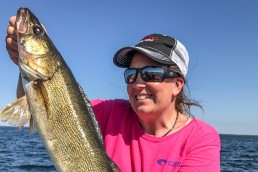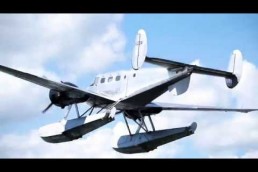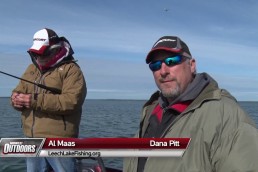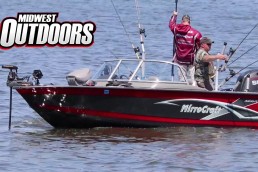Midsummer Reflex Walleye Bites
SHARE THIS POST
July has the hottest daily temperatures of the year and the highest water temperatures of the summer. The sun can be up for 15 hours a day, so all fish species have plenty of time to choose when to feed.
Walleyes wait until the conditions are favorable for them to feed, and spend the rest of the day trying to stay cool by avoiding the bright sun.
Walleyes are perfectly capable of feeding after dark, so they may not start actively feeding until the sun is hitting the tops of the tree line. Walleyes may also feed early in the morning, when most anglers are still trying to get a couple more hours of sleep.
But thankfully, not all walleyes do the same thing at the same time. There can be walleyes feeding at any time of day—or night—in many different parts of most lakes.
There will always be slow feeding periods during the day—when the conditions aren’t favorable, most of fish will take a break. Anglers want to be in the right place at the right time so they can take advantage of the best feeding windows during the day.
But fish also use their reflexes when they feed to take advantage of feeding opportunities that suddenly present themselves while the predator fish aren’t actively feeding. An inactive walleye may strike out suddenly if the right opportunity comes close enough to its resting position. If the fish don’t strike when the opportunity presents itself, they miss the chance to feed.
Fish like walleyes need to make a split-second decision to strike at the prey during their short window of opportunity. This reaction strike is what anglers are trying to get when they use fast moving spinner rigs on a bottom bouncer.
Anglers need to find triggers that will make fish strike at their presentations. The variables they need to control include speed, color, scent, flash, vibration and profile.
Water temperatures usually increase during July, which speeds up the metabolism in the fish and forces them to feed more frequently to keep up with their bodies’ demands for calories. It is possible for a healthy fish to gain weight during the summer if the right kinds of foods are plentiful in their lake.
Algae blooms usually peak in late July on many lakes, which can change fish location and has a negative effect on water clarity and oxygen levels in the lakes—this is especially true in the portion of the lake below the thermocline.
Are you enjoying this post?
You can be among the first to get the latest info on where to go, what to use and how to use it!
Mortality rates increase for fish that can’t find enough to eat or for fish that are injured. The fish need to heal fast enough to resume normal feeding patterns, or they could become a summer-kill casualty.
Heading into July, fish are more spread out within a given lake than they are at any other time of year. But as July progresses, water temperatures and oxygen levels often force the fish to concentrate into specific types of areas and begin to avoid other parts of the lake with low oxygen levels or areas that don’t have enough forage to support predators.
During the summer, walleyes need to stay where the oxygen levels are adequate, the water temperatures are tolerable and suitable food sources are readily available. Anglers need to keep all these factors in mind as they search for active walleyes.
More lakes are affected by invasive species every year, which is changing the environment for the fish. Anglers need to adjust their tactics to keep up with the fish—it’s always helpful to try and learn some new tricks.
Once I locate an area holding walleyes, I use faster presentations to try for reflex bites from the walleyes that aren’t actively feeding. I usually travel somewhere between 1 and 2 mph when fishing spinner rigs for walleyes.
I like to use a 1-, 1 1/2- or 2-ounce Northland Rock Bottom Bouncer and a live bait spinner rig that I make out of Northland and Gamakatsu components. I decide what weight sinker to use based on the depth and how much weight it takes to keep my bottom bouncer close to the bottom.
I have had success using Northland Butterfly Blades with three to five beads above two #6 Gamakatsu Octopus hooks rigged in tandem, or a single #4 Gamakatsu open eye hook with either leeches or nightcrawlers.
I use the St. Croix Eyecon medium-action baitcaster rods in 7’6” or 8’6” and EVA grip handles that make them easier to get out of a rod holder than rods with cork handles. I like Daiwa line counter reels rigged with 12-pound Sunline SX 1 and a 10-pound Sunline fluorocarbon leader with a spinner rig.
I like to troll big flats (or other long trolling runs) in the mid depth range, in which can be scattered baitfish and individual pods of gamefish. I watch side imaging on my sonar while trolling, and mark potential areas to come back to and use “spot-lock” on my Minn Kota Ulterra, to cast jigs tipped with nightcrawlers, leeches, minnows or plastics—depending on what is available or what is the hot bait at the time.
MWO
SHARE THIS POST
Did you enjoy this post?
You can be among the first to get the latest info on where to go, what to use and how to use it!
Brian 'Bro' Brosdahl
Outdoor communicator Brian “Bro” Brosdahl lives in northern Minnesota. He is a walleye guide in the Cass Lake, Leech Lake and Lake Winnibigoshish areas. He is sponsored by Northland Fishing Tackle, Frabill/Plano, Aqua-Vu, Humminbird/Minn Kota, St. Croix Rods, Ranger Boats, and Evinrude. Guide inquiries: brosguideservice.com. Follow on social media.



